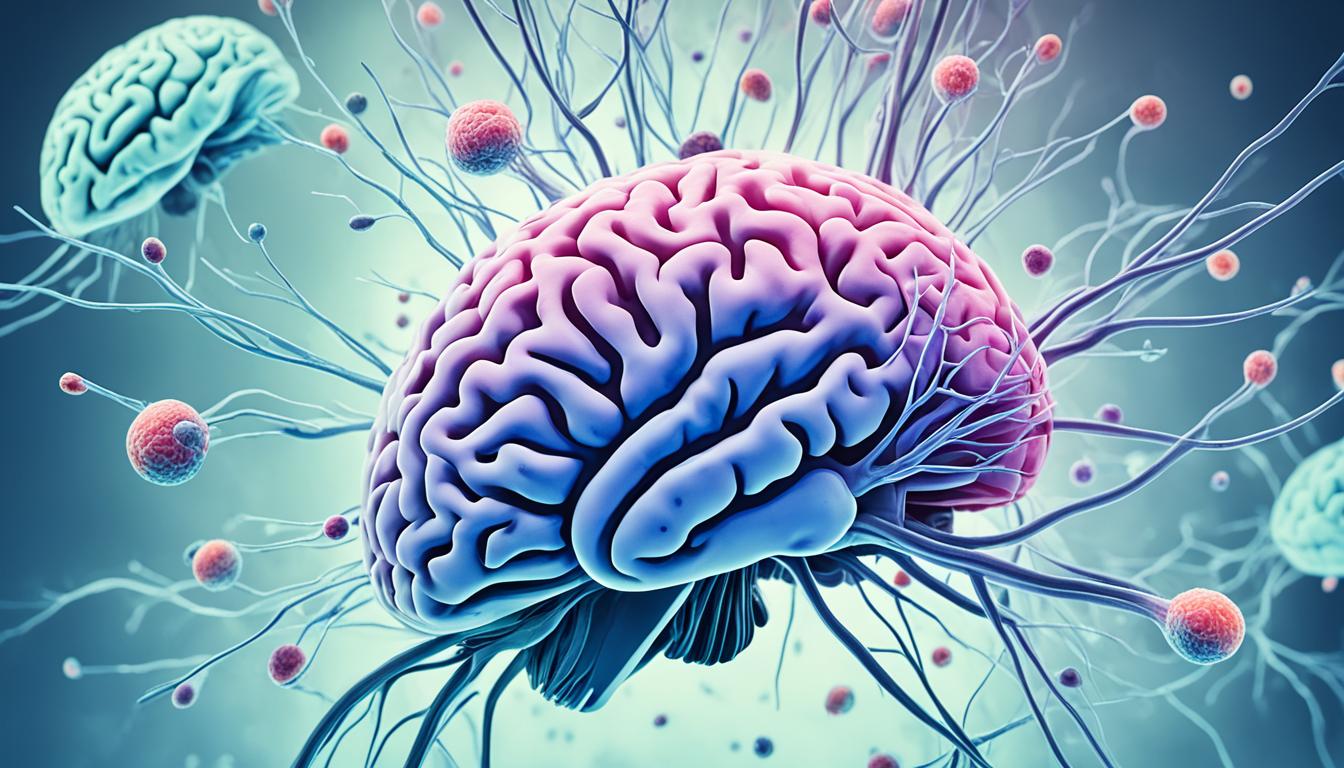Frontotemporal lobar degeneration (FTLD) is a type of dementia. It affects the frontotemporal lobes of the brain. This leads to language problems, changes in behavior, and memory loss. It often runs in families, with a genetic link.
Currently, there is no cure for FTLD. Doctors focus on easing symptoms and improving life quality. But, there’s hope with the progress in stem cell therapy.
Stem cell therapy uses stem cells to repair the brain’s damaged areas. It aims to fight the genetic causes of FTLD and grow new brain cells. Early research looks promising, hinting at its potential in treating these diseases.
Key Takeaways:
- Frontotemporal lobar degeneration (FTLD) affects the brain’s frontotemporal lobes.
- Symptoms include trouble in speaking, behavior changes, and memory loss.
- Many patients with FTLD have family members also affected. This hints at a strong genetic influence.
- Shrinking of the brain in its frontal and temporal lobes is a key sign of FTLD.
- Although there’s no cure yet, treatments help manage symptoms and enhance life quality.
- Stem cell therapy stands out as a possible future treatment for FTLD by addressing its genetic roots and regenerating brain cells.
Symptoms of Frontotemporal Lobar Degeneration
Frontotemporal lobar degeneration (FTLD) is a type of brain disorder. It brings a mix of problems in language, behavior, and thinking. Recognizing these signs helps doctors make the right diagnosis and plan the best care.
Language Impairment
People with FTLD often have a hard time with words. They might not find the right words, speak clearly, or understand others well. It can be very frustrating and make talking with others difficult. This leads to problems at work and in social settings.
Behavior Changes
FTLD shows up in how a person acts too. They might seem like they don’t care, don’t think about how others feel, do things without thinking, or act in ways that aren’t normal for them. Such behaviors can be surprising and hard for loved ones to see. They might risk more and do things that are unusual for them.
Cognitive Decline
In FTLD, thinking skills also take a hit. Memory, solving problems, and making choices become tougher. Normal tasks can start feeling really hard. This affects daily life and the ability to do things on their own.
Remember, the signs and how serious they are can differ with each FTLD type. Moreover, the effects depend on which part of the brain is most affected. Getting a clear diagnosis from a specialist in brain diseases is key. This helps in creating a care plan that fits the person’s needs.
Causes and Diagnosis of Frontotemporal Lobar Degeneration
The main cause of frontotemporal lobar degeneration (FTLD) is genetic. Several genes are involved in its development. These genetic mutations cause the frontotemporal lobes of the brain to degenerate. Brain atrophy, especially in the frontal and temporal lobes, marks the disease.
FTLD diagnosis requires a detailed clinical evaluation. This includes a deep look at the patient’s medical history and cognitive and behavioral checks. Neuroimaging studies are also needed. Genetic testing may be used to find specific mutations related to FTLD.
The Genetic Causes of Frontotemporal Lobar Degeneration
FTLD is caused by a variety of genes. Many genes play key roles in how FTLD grows. These genes include:
| Gene | Function |
|---|---|
| GRN | Helps make progranulin, a protein crucial for cell health and brain work. A lack of progranulin due to GRN gene mutations can cause FTLD. |
| C9orf72 | This gene has a repeat expansion that leads to wrong RNA and protein. It’s the most common cause of both linked and unlinked FTLD and similar diseases. |
| Tau (MAPT) | Encodes the tau protein that helps nerve cell structures. MAPT gene changes can make tau malfunction, causing FTLD. |
| CHMP2B | Controls protein movements and how cells work. Problems in CHMP2B can lead to FTLD by affecting protein tasks. |
Finding the precise genetic cause of FTLD is important. It helps predict how the disease will go, which guides treatment plans. Genetic advice and testing are essential for those with a family history of FTLD or similar conditions.
Stem Cell Therapy for Frontotemporal Lobar Degeneration
Stem cell therapy shows hope for dealing with frontotemporal lobar degeneration (FTLD). It’s a disease that affects the brain’s frontal and temporal lobes. This treatment uses stem cells to fix or change damaged cells. It targets the genetic issues of FTLD. This can help grow new brain cells.
Early studies on stem cell therapy for FTLD are promising. They show good results in similar brain diseases. This therapy doesn’t just ease symptoms. It also fights the main causes of FTLD. This is good news for patients and their loved ones.
But, more research is needed. We have to find out all the good and bad points of stem cell therapy for FTLD. Scientists are hard at work. They want to fully grasp how well this treatment works over time. They also want to make sure it’s safe for everyone.
With ongoing stem cell research, there’s hope for FTLD patients. The journey ahead might be long and challenging. But, stem cell therapy shines a light of hope. It could lead to better life results for these patients.

